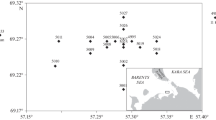Abstract
The meiobenthos was sampled at 119 localities along 1,500 km of Svalbard shores in the summers 1988–1993. The principal taxa were determined from 5-cm-long sediment cores collected during low tide on soft sediment shores. The density ranged from 0 to > 10,000 ind/10 cm2. Nematoda was the most common and abundant taxon. Nematoda and Turbellaria, along with Oligochaeta and Harpacticoida, were typical and the most frequent set of taxa. The occurrence of meiofaunal taxa was weakly correlated with geographical area; the local habitat characteristics were decisive. The most abundant meiobenthos, with mean abundance >900 ind/10 cm2 and the biomass about 0.34 g dry wt per 1 m2, was found on the western coast of South Spitsbergen.
Similar content being viewed by others
References
Artl G (1977) Verbreitung und Artenspectrum der Meiofauna im Greifswalder Bodden. Wiss Z Univ Rostock 26, Jahrg Math-Naturwiss Reihe 2:217–222
Elmgren R, Radziejewska T (1989) Recommendations for quantitative benthic meiofauna studies in the Baltic. BMB Publication 12:1–24
Faubel A (1982) Determination of individual meiofauna dry weight values in relation to definite size classes. Cah Biol Mar 23:339–345
Feder HM, Paul AJ (1980) Seasonal trends in meiofaunal abundance on two beaches in Port Valdez, Alaska. Syesis 13:27–36
Fricke AH, Flemming BW (1983) Selective microhabitat colonisation by interstitial meiofauna as a function of grain size, In: McLachlan A, Erasmus T (eds) Sandy beaches as ecosystems. Junk, The Hague: 421–431
Galtsova VV (1971) A quantitative characteristic of meiobenthos in the Chupinsky Inlet of the White Sea. Zool Zh 50:641–647
Galtsova VV, Platonova TA (1980) Distribution of meiofauna from muddy-sand beach of Dalnezelenetsky Bay, Barents Sea. Biol Mar 2:15–20
Gerlach SA (1965a) Freilebende Meeresnematoden aus der Gezeitenzone von Spitsbergen. Veröff Inst Meeresforsch Bremerhaven 9:109–172
Gerlach SA (1965b) Über die Fauna in der Gezeitenzone von Spitsbergen. Bot Gothobata Acta Univ Gothob 3:81–92
Hennig HF-KO, Eagle GA, Fielder L, Fricke AH, Gledhill WJ, Greenwood PJ, Orren MJ (1983) Ratio and population density of psammolittoral meiofauna as a perturbation indicator of sandy beaches in South Africa. Environ Monit Assess 3:45–60
Jończyk E, Radziejewska T (1984) Temporal changes in sand meiofauna of a southern Baltic beach. Limnologica 15(2):421–423
Juario JV (1975) Nematode species composition and seasonal fluctuation of a sublittoral meiofauna community in the German Bight. Veröff Inst Meeresforsch Bremerhaven 15:283–337
Kholodov VI, Kisseleva MI (1985) Statistical analysis of the influence of various sediments on the abundance of macro- and meiobenthic organisms. Biol Morya 2:17–25
Koop K., Griffiths CL (1982) The relative significance of bacteria, meio- and macrofauna on an exposed sandy beach. Mar Biol 66:295–300
McLachlan A (1977) Composition, distribution, abundance and biomass of the macrofauna and meiofauna of four sandy beaches. Zool Afr 12(2):279–306
Mielke W (1974) Eulitorale Harpacticoidea (Copepoda) von Spitsbergen. Mikrofauna Meeresbodens 37:161–210
Munro ALS, Wells JBJ, McIntyre AD (1978) Energy flow in the flora and meiofauna of sandy beaches. Proc R Soc Edinburgh 76b:297–315
Nicholas WL (1984) The biology of free-living nematodes. Clarendon Press, Oxford
Radziejewska T, Stańkowska-Radziun M (1979) Intertidal meiofauna of Recherchefjorden and Malbukta, Vest-Spitsbergen. Sarsia 64:253–258
Radziejewska T, Stańkowska-Radziun M (1985) Primary investigations of meiobenthos in Hornsundfjord. Materiaŀy Sympozjum Polarnego PTG, Szczecin: 106–111
Węsławski JM, Wiktor J, Jajączkowski M, Swerpel S (1993) Intertidal zone of Svalbard. 1. Macroorganism distribution and biomass. Polar Biol 13:73–79
Widbom B (1984) Determination of average individual dry weights and ash free dry weights in different sieve fractions of marine meiofauna. Mar Biol 84:101–108
Witte JIJ, Zijlstra JJ (1984) The meiofauna of a tidal flat in the western part of the Wadden Sea and its role in the benthic ecosystem. Mar Biol Prog Ser 14:129–138
Author information
Authors and Affiliations
Rights and permissions
About this article
Cite this article
Szymelfenig, M., Kwaśniewski, S. & Węsławski, J.M. Intertidal zone of Svalbard. Polar Biol 15, 137–141 (1995). https://doi.org/10.1007/BF00241052
Received:
Accepted:
Issue Date:
DOI: https://doi.org/10.1007/BF00241052




